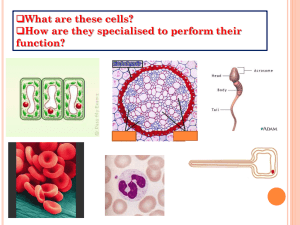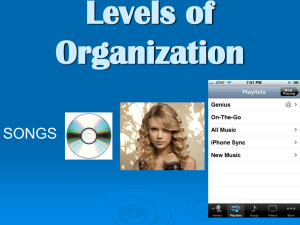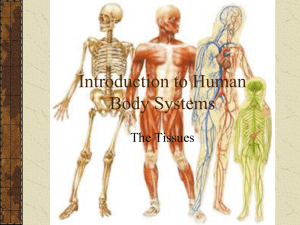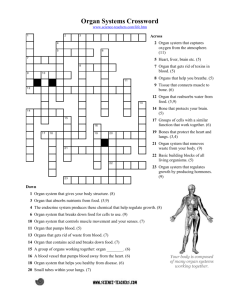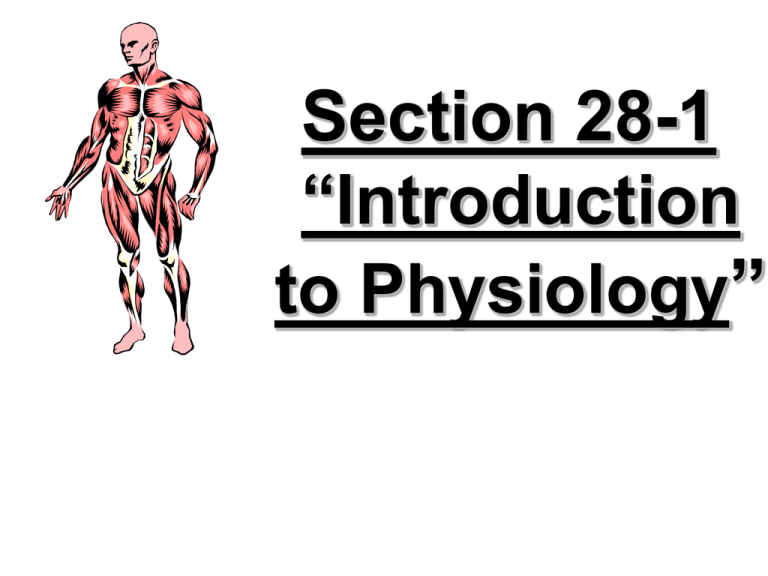
Section 28-1
“Introduction
to Physiology”
28.1 Levels of Organization
KEY CONCEPT
The human body and other
organisms have five levels of
organization.
28.1 Levels of Organization
A. Levels of Structural Organization
Atom
Molecule
Cell
Tissue
Organ
Organ System
Organism
28.1 Levels of Organization
Examples:
Atom
Molecule
Cell
Tissue
Organ
Organ System
Organism
≈ carbon
≈ phospholipid
≈ nerve cell
≈ nervous tissue
≈ brain
≈ nervous system
≈ human
28.1 Levels of Organization
1. Atoms combine to form molecules
Atoms
Molecule
28.1 Levels of Organization
2. Molecules form cells
Molecules
Cell
28.1 Levels of Organization
a. Specialized cells develop from a
single zygote.
• Organisms are made up of specialized
cells.
red blood cell
nerve cell
28.1 Levels of Organization
• Zygotes first divide into embryonic stem cells.
• Stem cells develop in
two stages.
– determination, or
committing to
become one cell type
– differentiation, or
acquiring specialized
structures and
functions
28.1 Levels of Organization
3. Cells form tissues
Similar cells with a
common function
form tissues
• There are 4 basic
tissue types:
• Epithelial
• Nervous
• Muscular
• Connective
28.1 Levels of Organization
4. Specialized cells function together in
tissues, organs, organ systems, and the
whole organism.
• Specialized cells perform specific
tasks.
• Tissues are groups of
similar cells working
together.
– epithelial tissue
– connective
tissue
– muscle tissue
– nervous tissue
cell
tissue
28.1 Levels of Organization
5. Tissues form organs
• Two or more tissue types form
an organ
An organ is a structure that
performs a specific function
for the body
28.1 Levels of Organization
6. Organs form Organ Systems
• A group of organs which
work together for a common
purpose is an organ system
Brain, Spinal Cord, etc.
Nervous System
28.1 Levels of Organization
B. Body Systems
1. Integumentary System
Skin is the only organ
Protects from injury
Regulates body temperature
Receptors for temperature, pain,
and pressure
28.1 Levels of Organization
2. Skeletal System
Bones, cartilage, ligaments, and
joints
Supports body
Protection
Storage for minerals (calcium)
28.1 Levels of Organization
3. Muscular System
Muscles contract (shorten)
to cause movement
• Skeletal muscles are large,
fleshy, and attached to bone
28.1 Levels of Organization
4. Nervous System
Brain, spinal cord,
nerves, & sensory
receptors
• Responds to
irritants or stimuli
28.1 Levels of Organization
5. Endocrine System
Releases hormones to control:
Growth
Reproduction
Food use
28.1 Levels of Organization
6. Circulatory System
Made of 2 organ systems:
Cardiovascular System:
- Heart and blood vessels
- Transport oxygen, etc.
Lymphatic System:
- Cleanses blood, immunity
28.1 Levels of Organization
7. Respiratory System
• Nasal passages,
pharynx, larynx,
trachea, bronchi, lungs
Supplies body with
oxygen
Removes carbon dioxide
28.1 Levels of Organization
8. Digestive System
• Mouth, oral cavity, pharynx,
esophagus, stomach, small
intestine, large intestine,
rectum
Breaks down food and
delivers nutrients to
blood for cells in the
body
28.1 Levels of Organization
9. Urinary System
• Kidneys, ureters, bladder, and
urethra
• Removes Nitrogen-containing
wastes from the blood and
flushes them from the body in
urine
Regulates:
– Water balance
– Salt balance
– pH (acid-base) balance
28.1 Levels of Organization
10. Reproductive System
Functions to produce offspring
• Male testes produce sperm
Male Structures: scrotum, penis,
accessory glands, duct system
• Female ovaries produce eggs
Female structures: uterine tubes,
vagina, uterus (where fetus develops)
28.1 Levels of Organization
All of the organ systems form the organism
28.1 Levels of Organization
Activity – Due end of the period Thursday.
• You are going to create a mini poster with your table
partner. You will make them for 2 organ systems.
• Layout of Poster (Follow this layout, or lose points…)
Major Organ System: (Name organ here)
Major Tissues & Organs
Primary Function
____________________
______________
____________________
______________
____________________
______________
*Must have 2-3 pictures*







